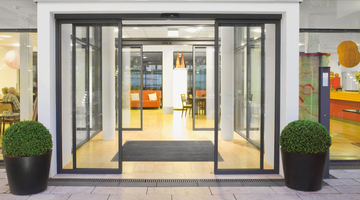Seamless Integration of Hotel Robots with Automatic Sensor Doors: Technical Implementation
To achieve seamless coordination between hotel service robots and automatic sensor doors, the following technical requirements must be addressed:
1. Technical Interface Alignment
Signal Transmission Protocol Compatibility
-
Compatible Control Systems
Ensure the robot’s control system and the automatic door’s control system adopt compatible communication protocols (e.g., RS-485, TCP/IP). Unified protocols enable the robot to send precise door opening/closing commands while receiving real-time status feedback (e.g., door position, operational readiness) from the sensor door. -
Bidirectional Communication
Implement a two-way data exchange mechanism to verify command execution (e.g., confirming door clearance before robotic navigation).
Sensor Calibration and Precision Matching
-
Adaptive Detection Ranges
Align the robot’s proximity sensors (e.g., ultrasonic, infrared) with the automatic door’s sensing range. Typically, hotel automatic doors are set to detect objects within 2–3 meters, while the robot’s sensors require centimeter-level precision to trigger door activation at optimal proximity.
2. Path Planning and Navigation
Environment Mapping and Localization
-
Precision Mapping
Utilize LiDAR, computer vision, or other mapping technologies to create detailed indoor maps, including marked zones for automatic doors. -
High-Accuracy Positioning
Integrate indoor positioning systems (e.g., UWB, Bluetooth/Wi-Fi triangulation) to enable the robot to track its real-time location relative to automatic doors.
Dynamic Path Optimization
-
Obstacle-Aware Routing
Generate optimal paths to automatic doors while accounting for dynamic obstacles (e.g., human traffic, objects). Algorithms should adjust routes in real time to avoid collisions and ensure smooth navigation.
3. Speed and Timing Coordination
Speed Matching
-
Synchronized Movement
Align the robot’s speed (typically 0.5–1 m/s) with the door’s opening/closing time (2–3 seconds). This ensures the robot passes through the door before it fully closes.
Time Synchronization
-
Clock Synchronization
Use system clocks or timestamp-based protocols to synchronize actions between the robot and the door, ensuring timely responses (e.g., initiating movement only when the door is confirmed open).
4. Safety and Reliability Design
Multi-Layered Safety Mechanisms
-
Obstacle Detection and Emergency Stop
Equip the robot with real-time obstacle detection (e.g., LiDAR, cameras) to halt movement if an obstruction is detected. Similarly, automatic doors should reverse opening if an object is sensed during closure. -
Fail-Safe Protocols
Implement redundancy measures, such as backup navigation modes (e.g., manual override) for robots and manual emergency stop buttons for doors.
Real-Time Fault Diagnosis
-
Automated Error Handling
Enable systems to self-diagnose issues (e.g., communication failures, sensor malfunctions) and trigger recovery protocols (e.g., switching to backup systems, sending alerts to maintenance teams).

